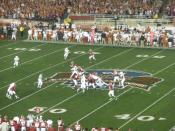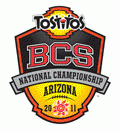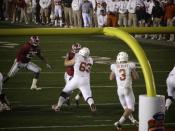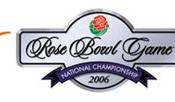November 17, 2009AbstractDivision I football is the only college sport that does not have a playoff system to determine its national champion. Instead, they utilize the Bowl Championship Series (BCS) to pair the top two teams in one national championship game, with the winner crowned the national champion. The BCS has been widely debated since its inception and continues to be the topic of heated arguments every year in the media, the workplace, and among friends. Only on rare occasions has the BCS produced a national champion while leaving most seasons in controversy. Information presented enforces why a college play-off system is the best way to declare a true national champion.
Bowl games have been a proud tradition of college football for many years and each bowl has affiliations with certain football conferences. With the exception of the Rose Bowl, which traditionally matches the Big Ten champion and the Pacific-10 (PAC-10) champion, bowl-conference affiliations historically have not showcased contests between two conference champions.
Rather, they served as the reward for one conference champion versus a worthy opponent from another conference (Fox Sports, 2009).
In 1992, the commissioners of several conferences, representatives from Notre Dame, and four bowl committees created the Bowl Coalition agreement. The agreement attempted to match up the top two teams in a national championship game, and to provide quality bowl match-ups for the champions of its member conferences. In the previous 57 years of post-season bowls, the top two teams had met only nine times. The Bowl Coalition existed for 3 years from 1992 to 1994, and was quite successful at pairing the top two teams in 2 of its 3 years of existence; however, there were limitations. For example, the champions of the Big Eight would never be able to play the champions of the Southeastern Conference (SEC) in any bowl game because of their affiliation with certain bowls. Additionally, because the PAC-10 and Big Ten retained their affiliation with the Rose Bowl, they did not participate in the Bowl Coalition, preventing them from ever playing the champion of another conference (Fox Sports, 2009).
In 1995, the bowl relationships were modified to retain the historic bowl venues while increasing the chances of matching the top two teams in the country. This system, the new Bowl Alliance, allowed the champions of the Atlantic Coast Conference (ACC), Big East, Big Eight, SEC, and Southwest Conferences along with an at-large team to be matched in the three Alliance bowls ÃÂ Fiesta, Sugar, and Orange, with the championship game rotating each year among the three. A second at-large team was added during the 1996 season when the Big Eight and Southwest Conferences merged to create the Big 12 conference. The Bowl Alliance improved the opportunity to produce a national championship game by eliminating automatic conference champion tie-ins to the three aforementioned bowl games, giving them the flexibility to choose the best match-ups. It also included two at-large spots which were open to all Division I teams that won at least eight regular season games, were ranked in the top 12, or were ranked no lower than the lowest ranked conference champion participating in the Alliance. The Bowl Alliance lasted for three seasons until the BCS was instituted in 1998 (Fox Sports, 2009).
Although the Bowl Alliance was successful, the conference commissioners and chief executive officers wanted to integrate the Big Ten and PAC-10 champions into a bowl arrangement that would allow for an annual pairing of the top two teams in the country. Both conferences, along with the Rose Bowl, agreed to add the Rose Bowl into the rotation with the Fiesta, Sugar, and Orange bowls for the national championship game; however, the BCS did not guarantee that the next six ranked teams would automatically receive invitations to the other three bowl games. The bowls were given discretion to select teams that would enhance ticket sales. A new mathematical formula was created to determine the BCS standing and assist in the selection of the participants in the four BCS games. The formula consisted of four elements including the human polls of sports writers and coaches, the average of three computer rankings, the teamsÃÂ records, and a teamÃÂs schedule strength based on the records of a teamÃÂs opponents and its opponentsÃÂ opponents. From 1998 until now, the BCS has annually tweaked their formula and changed rules in an effort to truly produce a national champion, including the 2006 addition of a fifth BCS bowl game designated as the National Championship game (Fox Sports, 2009).
Since the creation of the BCS, almost every year has ended in controversy and this year will probably be no different. During the 1998-1999 seasons, Kansas State finished third in the BCS standings but did not receive a bid to a BCS bowl game while lower ranked teams did. As a result, the BCS created the ÃÂKansas State RuleÃÂ that said teams ranked fourth or higher in the final rankings would be guaranteed a BCS bowl game (Wikipedia, 2009; Associated Press, 1998-2009).
The 1999-2000 season ended in controversy when Tulane finished their season undefeated and was denied a BCS game because they were not a member of a BCS conference. Kansas State was also denied a BCS game despite finishing sixth in the final BCS standings while eighth ranked Michigan did receive a BCS bowl invitation (Wikipedia, 2009).
During the 2000-2001 season, Oklahoma was the only team to finish the regular season undefeated. There were three legitimate one-loss teams who could have played Oklahoma in the national championship game. Florida State was chosen to be OklahomaÃÂs opponent despite losing earlier in the season to Miami who was ranked second in both human polls. Miami also had only one loss and was expecting the opportunity to play for the championship, especially since they had already beaten Florida State. This controversy resulted in the BCS adding a ÃÂquality winÃÂ factor to the BCS formula (Wikipedia, 2009; Associated Press, 1998-2009).
At the end of the 2001-2002 season, Nebraska was chosen to play Miami in the national championship game despite being ranked fourth in both human polls, and not winning their conference title. Nebraska lost to Miami in the title game while Oregon, ranked second in both human polls and fourth in the BCS, won their bowl game. Many argue that Oregon should have been chosen over Nebraska to play Miami for the national championship, but were denied that opportunity based on the strength of their schedule (Wikipedia, 2009; Associated Press, 1998-2009). The 2002-2003 season was not disputed.
The 2003-2004 season ended with six one-loss teams. Three of the six one-loss teams were from BCS conferences while the other three were not. Louisiana State University (LSU) defeated Oklahoma in the designated national championship game, while the University of Southern California (USC) beat Michigan in their BCS bowl to retain the top ranking in the Associated Press Poll. LSU was deemed the BCS national champion and USC was named the Associated Press national champion. The BCS was designed to eliminate split national champions and failed to do so during this season (Wikipedia, 2009; Associated Press, 1998-2009).
The 2004-2005 seasons ended with five undefeated teams, leaving three teams out of the national title picture. Oklahoma and USC were chosen to play in the championship game while Auburn, Utah and Boise State went to other bowls. USC beat Oklahoma in the title game while Auburn and Utah both won their bowl games to finish the year undefeated. If the BCS was designed to produce a national champion in Division I football, how can we truly deem USC the 2004-2005 champions when two other Division I teams finished undefeated? Because of the controversy during this season, the Associated Press requested the BCS no longer use their rankings in the BCS formula (Wikipedia, 2009; Associated Press, 1998-2009).
There was no controversy over the two teams chosen to play in the 2005-2006 national championship game; however, Notre Dame was chosen as an at-large team over fifth ranked Oregon despite a loss to an unranked opponent. This was due to a clause that gives Notre Dame an automatic bid to a BCS bowl game if it finishes in the top eight of the BCS rankings because Notre Dame is not a member of any conference (Wikipedia, 2009).
Boise State finished the 2006-2007 season undefeated and beat Oklahoma in a BCS bowl game to remain unbeaten. Undefeated Ohio State and Florida, with one loss, played in the national championship game. Florida (GO GATORS!) beat Ohio State in the championship game leaving Boise State the sole undefeated team that season. Despite the perfect season, Boise State had no claim to the title because they did not play for the national championship (Wikipedia, 2009).
The 2007-2008 seasons were no different from the rest. Hawaii almost went undefeated, but lost to Georgia in the 2008 Sugar Bowl and was never given the opportunity to play for the national championship due to their low rated strength of schedule. Hawaii plays in the Western Athletic Conference (WAC) and the majority of their games are against other WAC schools. Does this mean that the WAC is a weak conference? If so, maybe the teams in the WAC shouldnÃÂt be Division I. Ironically, Boise State, the sole undefeated team from the 2007 season, is also a member of the WAC. Division I is Division I! When a team is the only undefeated team in the country, they should be allowed to play for the title, regardless of their conference affiliation. Except for the 2008-2009 when there was little controversy when the number two ranked Florida Gators beat the number 1 ranked Oklahoma Sooners (GO GATORS!) the evidence presented thus far overwhelmingly demonstrates that the BCS has not achieved its goal of placing the top two teams in the national championship game. Will the 2009-2010 seasons be as it was in 2007-2008?I propose a playoff system to determine the Division I football champion. Even president Obama supports the idea of an eight game play off system and has even been stated that he may ÃÂstart throwing my weight aroundÃÂ in order to find a system that identifies a true national champion (Sporting News 2009). Many argue against a playoff because they claim it adds undue academic burdens on the players due to the additional games, but I disagree. Division II and III teams determine their champion via a playoff system and have been doing so for many years. Is the academic success of their students less important than the academic success of Division I players? Of course not! There are currently 11 conferences in Division I football with 119 teams, and there are 32 bowl games at the end of each football season, allowing 64 teams the opportunity to play a post-season game. If those 64 teams were allowed to participate in a playoff, the BCS games and sites could still be utilized for the quarter-finals, semi-finals, and the championship game.
WeÃÂll likely never see a playoff system because the major conferences and bowls are afraid theyÃÂll lose money. The five BCS bowls earn astronomical amounts of money from sponsors and fans, producing massive payouts to the conferences whose schools are chosen to play in those games. I think the playoff system described above would generate more revenue because thereÃÂd be more games played at the end of the season. Face it, if fans will travel to see their team play in the first round of the playoffs, theyÃÂll likely continue their support if the team continues to win.
Until the conferences, bowl officials, and the National Collegiate Athletic Association decide to change the BCS, only on rare occasions will we ever have a true national champion, and teams like Hawaii and all the other teams in non-BCS conferences have no chance of playing in the title game. Collegiate football players are not professionals and are not paid for their performance. They play for the love of the game, so give them the opportunity to achieve their goal of playing for a national championship.
References:Coakley, J. (2009). Sports in Society: Issues and Controversies. New York, New York: McGraw-Hill Companies, Inc.
Fox Sports (2009). BCS Chronology. Retrieved November 1, 2009 from http://www.bcsfootball.org/bcsfb/historySporting News (2009). Utah senator urges Obama to investigate BCS. Retrieved November 10, 2009 from http://www.sportingnews.com/college-footballWikipedia (2009). Bowl Championship Series. Retrieved October 20, 2009 from http://en.wikipedia.org/wiki/Bowl_Championship_SeriesAssociated Press (1998-2009). BCS History Lesson. Retrieved November 1, 2009 from http://ncaasports.com/football/mens/story/8975902Suggs, W. (2005). A Place On The Team. Princeton, New Jersey: Princeton University Press (2005).
Appenzeller, H. and Appenzeller T. (2008). Successful Sport Management 3rd Edition. Durham, North Carolina: Carolina Academic Press (2008).
Sawyer T. and Smith, O. (1999). The Management of Clubs, Recreation and Sport Concepts and Aplications. Champaign, Illinois: Sagamore Publishing (1999).





